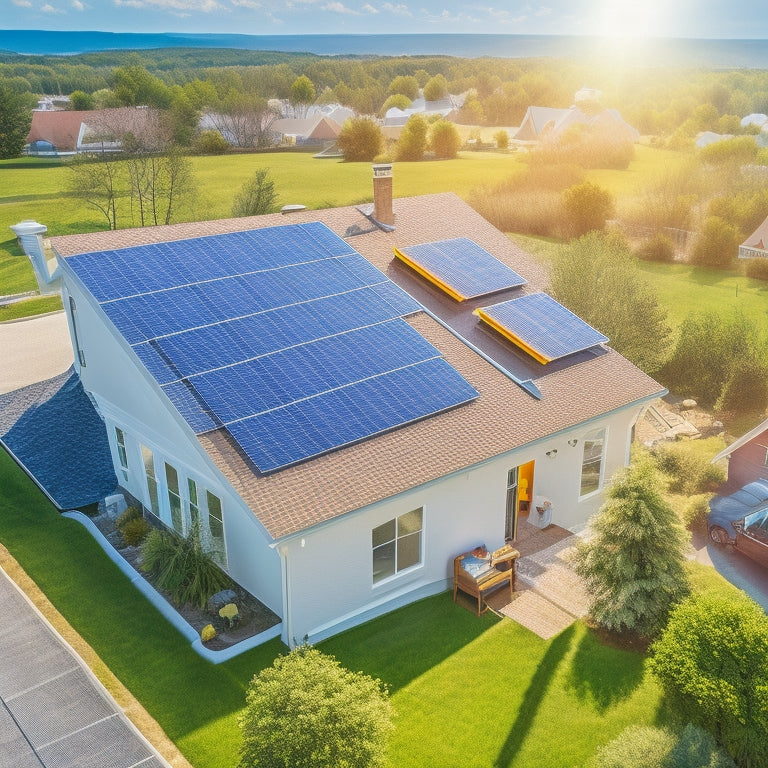
Planning and Executing Home Roof Solar Panel Installation
Share
You're about to set out on a successful home roof solar panel installation, but first, you need to assess your home's solar potential by evaluating sunlight exposure, roof orientation, and obstructions. Then, choose the right solar panel by considering types, efficiency ratings, durability, and warranty options. Navigate local building codes, obtain necessary permits, and prepare your roof for installation by inspecting its condition and clearing debris. By understanding solar panel costs, planning for energy storage, and excelling in installation logistics, you'll be well on your way to a seamless installation. Now, get ready to plunge into the details and make your solar dreams a reality.
Key Takeaways
- Assess your roof's solar potential by evaluating sunlight exposure, orientation, slope, and obstructions to determine the ideal placement for solar panels.
- Choose the right solar panel type, considering efficiency, durability, and warranty, to meet your energy needs and budget.
- Ensure compliance with local building codes, electrical and fire safety standards, and obtain necessary permits before installation.
- Prepare your roof for installation by inspecting its condition, verifying structural integrity, clearing debris, and addressing obstacles.
- Select a qualified installer with proper credentials, certifications, and reviews to ensure a high-quality installation for optimal performance and longevity.
Assessing Your Home's Solar Potential
Determine your home's solar potential by evaluating its exposure to sunlight, an essential step in deciding whether solar panels are a viable option for you. This involves conducting a solar exposure analysis to identify the amount of sunlight your roof receives throughout the day.
You'll need to assess factors such as the orientation of your roof, the slope of your roof, and any obstructions that may block sunlight.
Next, you'll need to perform a shading assessment to identify any areas of your roof that receive partial or full shade. This can include trees, buildings, and other obstructions that may impact the performance of your solar panels.
Choosing the Right Solar Panel
Your solar panel expedition begins with selecting the right panel for your home's unique needs.
You'll encounter various solar panel types, each with its strengths and weaknesses. Monocrystalline panels boast high efficiency ratings, making them ideal for small roofs with high energy demands. Polycrystalline panels, on the other hand, offer a more affordable option without sacrificing too much efficiency. Thin-film panels are another option, suitable for large roofs with low energy requirements.
When choosing a solar panel, reflect on its efficiency rating, which indicates how well it converts sunlight into electricity. Look for panels with high efficiency ratings (above 20%) for maximum energy production.
You'll also want to contemplate the panel's durability, warranty, and temperature coefficient, which affects its performance in hot climates.
Ultimately, the right solar panel for you'll depend on your energy needs, budget, and roof size. By assessing these factors and understanding the strengths of each solar panel type, you'll be well on your way to utilizing the power of the sun.
Understanding Local Building Codes
You'll need to guarantee your solar panel installation complies with local building codes, which can vary considerably depending on your location.
Code compliance requirements, such as electrical and fire safety standards, will impact your system's design and installation.
You'll also need to take into account roofing material restrictions and maneuver through the permitting process essentials to avoid costly delays or rework.
Code Compliance Requirements
In accordance with local building codes, homeowners must guarantee their solar panel installation meets specific standards to avoid costly rework and potential safety hazards. Failure to comply can result in financial losses and even compromise the safety of your family and neighbors.
To facilitate a smooth installation process, it is crucial to understand the code compliance requirements in your area. Here's a breakdown of the key aspects to focus on:
| Compliance Aspect | Description |
|---|---|
| Electrical Connection | Confirm your solar panel system meets grid connection requirements, including voltage, current, and frequency standards. |
| Structural Integrity | Verify that your roof can support the weight of the solar panels and withstand environmental factors like wind and snow. |
| Fire Safety | Comply with local fire safety regulations, including clearance requirements and emergency access pathways. |
| Permits and Inspections | Obtain necessary permits and undergo inspections to validate your installation meets local building codes and standards. |
Roofing Material Restrictions
Three primary roofing material restrictions govern solar panel installations, guaranteeing the integrity of your roof and the safety of your solar panel system.
First, you'll need to evaluate roof type compatibility. Not all roofs are suitable for solar panels, and incompatible materials can lead to installation challenges or even void your warranty. For instance, solar panels can't be installed on roofs with active skylights, vents, or other protrusions that could obstruct the panels.
Secondly, you'll need to verify your roof's structural integrity can support the added weight of the solar panels. This is particularly significant for older roofs or those with existing damage.
Finally, local building codes may restrict certain roofing materials, such as asphalt shingles or clay tiles, due to their combustibility or fragility.
Understanding these restrictions will help you choose the right roofing material for your solar panel installation, avoiding potential installation challenges and guaranteeing a safe, efficient, and long-lasting system.
Permitting Process Essentials
Local building codes serve as a regulatory structure, governing the installation of solar panels on your rooftop. As you maneuver through the permitting process, it's crucial to understand these codes to guarantee a smooth and compliant installation.
You'll need to comply with local zoning regulations, which dictate the size, location, and appearance of your solar panel system.
| Code Requirement | Description |
| Building Permit | Required for installation, affirming compliance with local building codes |
| Electrical Permit | Verifies the electrical system meets safety standards |
| Zoning Approval | Confirms compliance with local zoning regulations |
| Environmental Review | Assesses the project's environmental impact |
| Inspection | Verifies the installation meets code requirements |
You'll need to provide detailed plans and specifications for your solar panel system, including the type and quantity of panels, mounting systems, and electrical components.
Be prepared to address any potential issues or concerns raised by local authorities, and factor in the time and cost of obtaining necessary permits and approvals.
Obtaining Necessary Permits
Before commencing your home roof solar panel installation, securing necessary permits is an essential step to guarantee compliance with local building codes and regulations.
You'll need to obtain permits from your local government, which may include electrical, building, and zoning permits. The type of permits required varies depending on your location and the scope of your project.
It's vital to understand the application timelines for each permit. Typically, you'll need to submit your permit applications well in advance of your installation date.
Be prepared to provide detailed plans and specifications of your solar panel system, including the type and number of panels, inverters, and mounting hardware.
Ensure you meet the necessary requirements and follow the application process carefully to avoid delays or rejections.
You may need to hire a professional to assist with the permitting process, especially if you're not familiar with local regulations.
Preparing Your Roof for Installation
With your permits in hand, you're now ready to focus on preparing your roof for the solar panel installation. This critical step guarantees your roof can support the weight of the solar panels and withstand various environmental conditions.
Before installation, it's crucial to assess your roof's condition and structural integrity. Here are key areas to inspect:
-
Roof Age and Condition: Check for signs of wear, damage, or deterioration, such as cracked, missing, or loose shingles, curled or buckled shingles, and signs of animal or insect infestation.
-
Structural Integrity: Verify that your roof's framing, trusses, and rafters can support the added weight of the solar panels.
-
Obstacles and Debris: Clear your roof of debris, such as leaves, branches, and skylights, to guarantee a smooth installation process.
- Roof Pitch and Orientation: Confirm your roof's pitch and orientation are suitable for solar panel installation, considering factors like shading and energy output.
Selecting a Qualified Installer
As you prepare for the installation of your home roof solar panels, it's essential to find a qualified installer who can guarantee a safe and efficient process. This decision will greatly impact the performance and longevity of your solar panel system.
To confirm you're making an informed choice, research potential installers' credentials, such as licenses, certifications, and industry affiliations. Verify their installer credentials, like NABCEP certification, which indicates proficiency in solar panel installation.
Additionally, read installer reviews from multiple sources, including online review platforms, the Better Business Bureau, and the installer's website. Pay attention to ratings, customer feedback, and any complaints or issues.
This will give you a thorough understanding of the installer's reputation and work quality. By doing your due diligence, you'll be confident in your chosen installer's ability to deliver a high-quality installation that meets your energy needs and provides long-term benefits.
Understanding Solar Panel Costs
Your investment in home roof solar panels comes with a significant upfront cost, but it's essential to understand the breakdown of these expenses to make an informed decision. The total cost of a solar panel system includes the equipment, installation, and permitting fees.
-
Equipment costs: The price of solar panels, inverters, and mounting hardware varies depending on the quality and efficiency of the components.
-
Labor costs: Installation, wiring, and electrical work are labor-intensive and account for a significant portion of the total cost.
-
Permitting and inspection fees: Local authorities require permits and inspections, adding to the overall cost.
- Additional features: Optional features like energy monitoring systems, tracking systems, or battery storage increase the total cost.
Fortunately, there are financing options and tax incentives that can help offset the initial investment. Federal and state governments offer tax credits and rebates, reducing the net cost of your solar panel system.
With a clear understanding of the costs involved, you can investigate financing options and make the most of the available incentives, making your shift to solar power more affordable and viable.
Planning for Energy Storage
To fully employ the benefits of solar power, it's essential to evaluate energy storage solutions that balance your consumption with the variable output of your solar panels.
You'll need to assess your energy usage patterns to determine the ideal battery type and size for your system. Lead-acid, lithium-ion, and flow batteries are popular options, each with their own advantages and limitations.
Consider factors like depth of discharge, round-trip efficiency, and lifespan when selecting the right battery for your needs.
Effective energy management is vital to maximizing your solar panel's potential.
You'll need to integrate a monitoring system that tracks your energy production and consumption in real-time. This data will enable you to enhance your energy usage, identify areas of inefficiency, and make informed decisions about energy storage.
Installation Day Logistics
The installation crew arrives at your doorstep, equipped with a fleet of vehicles and an arsenal of tools, ready to convert your roof into a solar powerhouse. As you watch them get to work, you'll notice a flurry of activity as they set up their equipment and begin installing the solar panels.
To guarantee a smooth and safe installation process, the crew will take the following precautions:
-
Conduct a thorough roof inspection to identify any potential hazards or weaknesses.
-
Establish a secure perimeter around the work area to prevent accidents and guarantee only authorized personnel have access.
-
Implement electrical safety measures, such as locking out electrical panels and using personal protective equipment (PPE).
- Designate a crew leader to oversee the installation timeline and guarantee that all tasks are completed efficiently and effectively.
Throughout the installation process, the crew will work efficiently to complete the job according to the predetermined installation timeline.
This will guarantee that your solar panel system is up and running as quickly as possible, providing you with the power and energy independence you desire.
Post-Installation Maintenance
With your solar panel system now installed, it's vital that you commit to a regular maintenance routine to assure peak performance and longevity. Regular maintenance helps prevent unexpected issues, guaranteeing you maximize your energy savings and reduce your carbon footprint.
| Task | Frequency | Description |
|---|---|---|
| Solar Panel Cleaning | Quarterly | Remove dirt and debris to maintain energy efficiency |
| Inverter Maintenance | Semi-annually | Check and replace inverters as needed to confirm proper energy conversion |
| Energy Monitoring | Monthly | Track energy production and identify potential issues |
| System Upgrades | As needed | Upgrade components to optimize performance and take advantage of new technologies |
In addition to these tasks, it's important to perform regular performance checks, troubleshoot issues as they arise, and manage your warranty to make sure you're protected in case of unexpected problems. By staying proactive with maintenance, you'll enjoy a hassle-free solar power experience and reap the benefits of clean, renewable energy.
Frequently Asked Questions
Can I Install Solar Panels on a Metal or Clay Tile Roof?
You can install solar panels on a metal roof, but confirm compatibility by checking the roof's structural integrity and using compatible mounting systems. For clay tile roofs, consider specialized tile clips and additional structural support to prevent damage.
Do Solar Panels Work During Power Outages?
You'll find that solar panels don't provide power during outages with traditional grid-tied systems, as they're designed to sync with the grid and shut down for safety reasons, but you can opt for battery-backed systems to maintain solar panel efficiency during outages.
Are Solar Panels Resistant to Hail and Extreme Weather?
You'll be relieved to know that solar panels are designed to withstand harsh weather conditions, including hail storms, thanks to their strong durability and rigorous testing, ensuring they can absorb weather impact without compromising their performance.
Can I Install Solar Panels on a Flat Roof or Skylight?
You can install solar panels on a flat roof, leveraging its advantages, but you'll need to take into account unique installation considerations, such as weighted ballast systems, to guarantee a secure and efficient energy-harnessing setup that meets your power needs.
Will Solar Panels Affect My Roof's Warranty?
You're probably wondering if solar panels will torpedo your roof's warranty - the answer is, not necessarily! A well-executed installation won't void warranty coverage, but it's important to guarantee the installation impact is minimal to maintain warranty validity.
Conclusion
As you flip the switch, utilizing the power of the sun to energize your home, remember the careful planning and execution that made it possible. Gone are the days of relying on the grid, replaced by the freedom and independence of renewable energy. Your roof, once a mere shelter from the elements, now a hub of sustainability, generating clean power and a sense of accomplishment.
Related Posts
-

Top-Rated Solar Storage Solutions for Homeowners
When considering top-rated solar storage solutions, you're looking at systems that provide energy independence and si...
-

Evaluating Solar Power Options for Businesses
Evaluating solar power options for your business can greatly reduce energy costs and enhance sustainability. Start by...
-

Innovative Sustainable Materials for Energy-Efficient Homes
Innovative sustainable materials enable you to create energy-efficient homes while promoting environmental responsibi...


